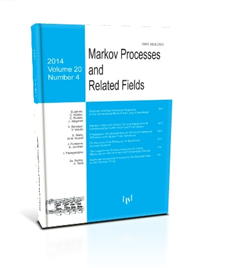The Empirical Eigenvalue Distribution of a Gram Matrix: From Independence to Stationarity
W. Hachem, P. Loubaton, J. Najim
2005, v.11, Issue 4, 629-648
ABSTRACT
Consider a $N\times n$ matrix $Z_n=(Z^n_{j_1 j_2})$ where the individual entries are a realization of a properly rescaled stationary Gaussian random field: \[ Z^n_{j_1 j_2} = \frac{1}{\sqrt{n}} \sum_{(k_1,k_2) \in \mathrm{Z}^2} h(k_1,k_2)\, U(j_1-k_1,j_2-k_2), \] where $h\in\ell^1(\math {Z}^2)$ is a deterministic complex summable sequence and $(U(j_1,j_2)$; $(j_1,j_2)\in \math {Z}^2)$ is a sequence of independent complex Gaussian random variables with mean zero and unit variance. The purpose of this article is to study the limiting empirical distribution of the eigenvalues of Gram random matrices $Z_n Z_n ^*$ and $(Z_n +A_n)(Z_n +A_n )^*$ where $A_n$ is a deterministic matrix with appropriate assumptions in the case where $n\rightarrow \infty$ and $N/n \rightarrow c \in (0,\infty)$. The proof relies on related results for matrices with independent but not identically distributed entries and substantially differs from related works in the literature [A. Boutet de Monvel, A. Khorunzhy and V. Vasilchuk, Limiting eigenvalue distribution of random matrices with correlated entries. Markov Processes Relat. Fields, 1996, v. 2, N4, 607-636. V.L. Girko, Theory of Stochastic Canonical Equations. Vol. I. Volume 535 of Mathematics and its Applications. Kluwer Academic Publishers, Dordrecht, 2001], etc.
Keywords: random matrix,empirical eigenvalue distribution,Stieltjestransform
COMMENTS
Please log in or register to leave a comment

